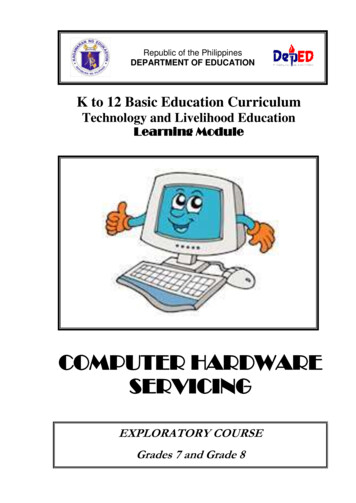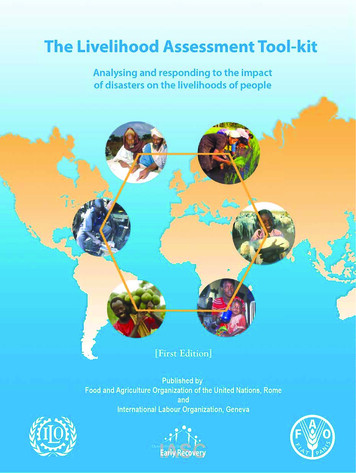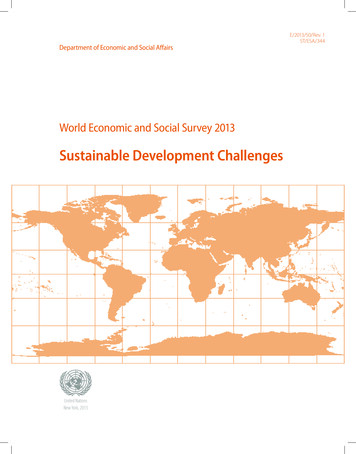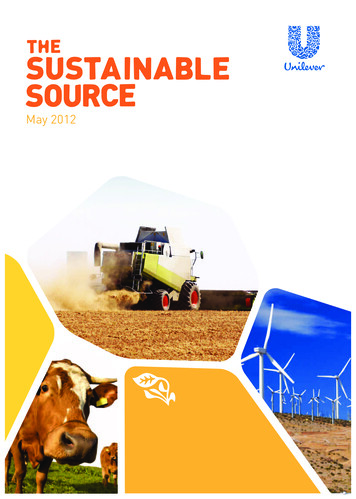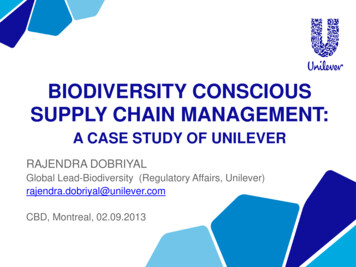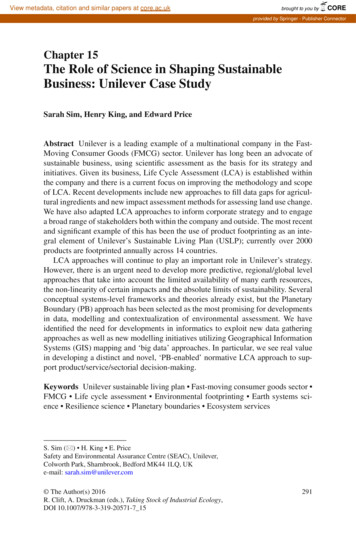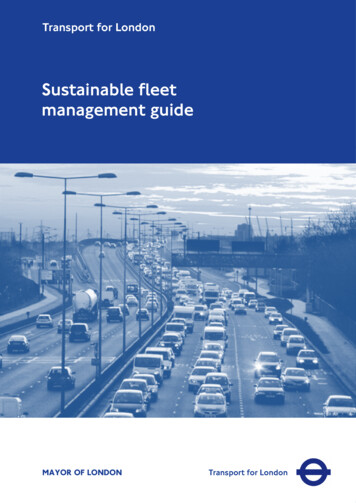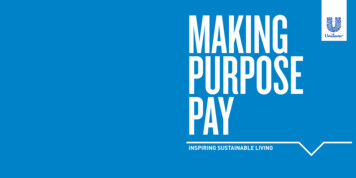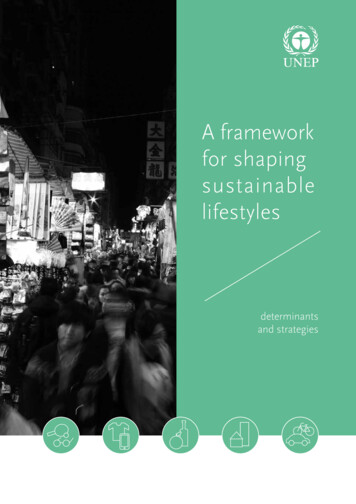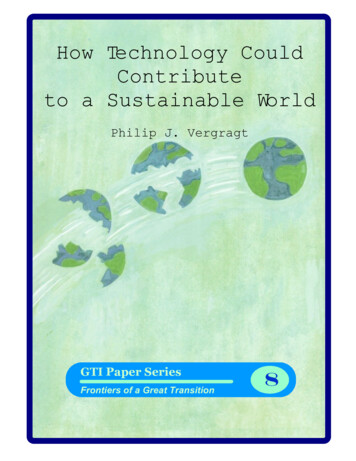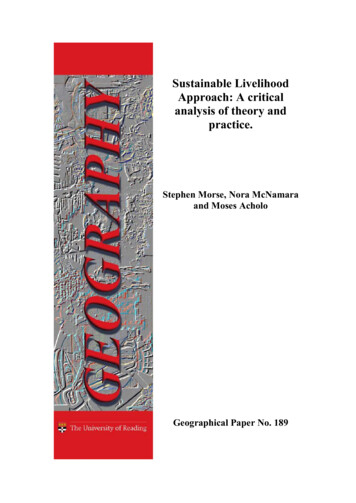
Transcription
Sustainable LivelihoodApproach: A criticalanalysis of theory andpractice.Stephen Morse, Nora McNamaraand Moses AcholoGeographical Paper No. 189
Sustainable Livelihood Approach: A criticalanalysis of theory and practice.Geographical Paper No. 189Stephen MorseDepartment of Geography, University of Reading, UKS.Morse@Reading.ac.ukNora McNamara and Moses AcholoDiocesan Development Services (DDS), Idah, Kogi State,NigeriaNovember 2009Series Editor: A.M.MannionA.M.Mannion@Reading.ac.uk1
ContentsSectionPage number1. Introduction42. The SLA context; two villages in Nigeria.163. The SLA space184. Practice of SLA215. Human capital: the households236. Natural capital: land and farming297. Natural capital: Trees378. Social capital: Networks409. Physical capital: assets for income generation4410. Financial capital: household budgets5211. Vulnerability context5612. Did SLA succeed?5813. Some conclusions6314. Acknowledgements6415. References642
AbstractSustainable Livelihood Analysis (SLA) has since the 1990s become the dominantapproach to the implementation of development interventions by a number of majorinternational agencies. It is defined in terms of the ability of a social unit to enhanceits assets and capabilities in the face of shocks and stresses over time. SLA first seeksto identify the important assets in livelihood, their trends over time and space as wellas the nature and impacts of shocks and stresses (environmental, economic and social)upon these assets. Following this, and after taking cognisance of the wider context(e.g. political, legal, economic, institutions, infrastructure etc.), interventions aredesigned to address any vulnerability of enhance livelihoods perhaps bydiversification of income streams. Thus SLA could be said to be a practicalframework for evidence-based intervention and has much logic resting behind it,especially in a world undergoing rapid change and where resources to supportdevelopment interventions are inevitably limited. However, putting SLA into practiceis not as easy as it may so often appear, and there are many overlaps with theproblems long-reported of making policy in general more evidence-based.Surprisingly there are relatively few reported attempts to take a more critical stance asto the feasibility of SLA and its ability to help deliver real change for people in thedeveloping world.This paper critically assesses SLA from the perspective of putting it into practice inone place: the middle belt of Nigeria. This experience is dovetailed into the existingliterature on SLA and to a lesser extent evidence-based policy to explore whereproblems occurred and how they can be addressed. The Nigerian case study is basedon the work of a Catholic Church development organisation (Diocesan DevelopmentServices; DDS) and its use of SLA to help provide the basis for changes it wasplanning to an existing intervention, namely micro-credit. The SLA was piggy-backedonto work it was contracted to do for the Department for International Development(DFID) and indeed the planned changes to the micro-credit scheme were also partly toensure longer-term impact arising out of the DFID project. Thus the context was onewhere the SLA was to some extent constrained by decisions that had already beentaken and the audience was at least in part other aid agencies that DDS wasapproaching to help support the micro-credit scheme. However, DDS had over 30years experience of working in the region and a wealth of expertise of engaging insuch village-level work. Further advantages were provided by a decision to focusonly on two „representative‟ villages and to implement the work over a two yearperiod in parallel with its evolution of the micro-credit scheme. Despite theseadvantages the implementation of SLA posed many problems and issues, andquestions need to be asked as to whether the approach really is a feasible basis forintervention or whether it is nothing more than a convenient label.3
1. IntroductionThe Sustainable Livelihood Approach (SLA) to development intervention has been invogue since the late 1990s and formed a central concept of the UK‟s Department forInternational Development‟s (DFID) strategy during the early years of the NewLabour government in the UK. The call for emphasis on sustainable livelihoods wasset out in the 1997 White Paper on international development as follows:“ refocus our international development efforts on the elimination of povertyandencouragement of economic growth which benefits the poor. We will do thisthrough support for international sustainable development targets and policiesthat create sustainable livelihoods for poor people, promote humandevelopment and conserve the environment”DFID (1997: Summary, page 6).What exactly are these „sustainable livelihoods‟ that DFID intends to help create? Onedefinition is provided by Chambers and Conway (1992) some 5 years before theWhite Paper:“A livelihood comprises the capabilities, assets (stores, resources, claims andaccess) and activities required for a means of living; a livelihood is sustainablewhich can cope with and recover from stress and shocks, maintain or enhanceits capabilities and assets, and provide sustainable livelihood opportunities forthe next generation; and which contributes net benefits to other livelihoods atthe local and global levels and in the short and long-term.”Chambers and Conway (1992, page 7).In this definition a number of strands coalesce. On the one hand there is a requirementfor livelihood to be able to recover from “stress and shocks” but also to be able to“maintain and enhance” capabilities and assets into the future. A central element inthis „resilience‟ to stress and shocks is the diversification of elements that comprise„livelihood‟.Just prior to publication of the White Paper Carney (1998) provides a simpler visionbut also one which has resonance with that of Chambers and Conway:“A livelihood comprises the capabilities, assets (including both material andsocial resources) and activities required for a means of living.”and, when merged with sustainability“A livelihood is sustainable when it can cope with and recover from stressesand shocks and maintain or enhance its capabilities and assets both now and inthe future, while not undermining the natural resource base.”SLA is an example of the „multiple capital‟ approach where sustainability isconsidered in terms of available capital (natural, human, social, physical andfinancial) and an examination of the vulnerability context (trends, shocks andstresses) in which these assets exist. An outline of SLA and suggestions for putting itinto practice can be found in „guidance notes‟ produced by DFID (available at4
www.nssd.net/references/SustLiveli/). Five principal assets (or capitals) aresuggested as important to livelihood and they are presented as a pentagon in Figure 1.Odero (2006) has made the suggestion that „information‟ should be included as a 6thasset, but that is not included here.Figure 1. The five capitals of sustainable livelihood (after Scoones 1998)Natural capitalnatural resource stocks (soil, water, air, genetic resources etc.) andenvironmental services (hydrological cycle, pollution sinks etc)Social capitalHuman capitalsocial resources (networks, socialclaims, social relations, affiliations,associations)skills, knowledge, labour(includes good health andphysical capability)Physical capitalEconomic or financial capitalInfrastructure (buildings, roads),production equipment andtechnologies)capital base (cash, credit/debt, savings, and othereconomic assets)Some of the capitals are straightforward i.e. buildings, machinery, land, cash and soon – while some are less immediately obvious – social networks, knowledge and goodhealth are examples. All are important although clearly the balance will change fromhousehold to household and over time. Thus even a relatively simple diagram such asFigure 1 has much embedded complexity.Once these assets have been identified and assessed in terms of the contribution theymake (or could make) it is necessary to explore the vulnerability context in whichthey exist; what are the trends, shocks and stresses? Thus it is not only a matter ofknowing what is happening now but also what the trends are and what could happenin the future. Some of the assets may change little over time (e.g. land and buildings)while others such as cash and social networks can be volatile and depend uponmovement of people into and out of the household. Vulnerability to shocks can alsovary. A drought for example will impact upon natural capital and in turn reduce cropyields, but may have little if any effect on other capitals. In the longer term, of course,a severe drought could impact on a wide range of capitals, including social and humanas people emigrate. Similarly, flooding may damage physical and natural capitalwhile having little impact on the others. Thus the capitals will vary in terms of theirresilience to different types of shock and the intensity of that shock.Moreover it is necessary to examine the policy and institutional context within whichthese capitals exist. While some capitals may be vulnerable to certain shocks it maybe that authorities are able to act and limit any damage which occurs or perhapsprovide recompense. While assets may be damaged by flooding there may bepublically owned structures in place to reduce the likelihood of the disaster occurring.Similarly, there may be publically funded extension services available which cansupplement the knowledge base of farmers or provide advice and help with irrigation5
systems. It is not only government services which need to be considered here as theymay be non-governmental or even private agencies at hand that can provide supportfor livelihoods. Only when all of this is considered can it be possible to developstrategies that help enhance livelihood (i.e. generate positive livelihood outcomes).The assumption is that these planned outcomes would feedback to enhance livelihoodassets and make them more resilient.The logic outlined above is the basis for SLA and is typically represented as set out inFigure 2. Thus SLA can be considered in a number of different ways (Farrington,2001):1. a set of principles guiding development interventions (whether community-ledor otherwise). The fundamental issue here is the notion that an interventionhas to be evidence-based rather than instigated in top-down fashion withoutadequate knowledge of the community.2. an analytical framework to help understand what „is‟ and what can be done.Thus the logic as set out here is to appreciate the capitals which are present,their vulnerability and the involvement of institutions. The logic provides aframework which can serve as the basis for an analysis.3. an overall developmental objective. In this case development is theimprovement of livelihood sustainability, perhaps by making capital lessvulnerable or by enhancing the contributions that some capitals can make oreven by improving the institutional context.It is these three – a set of principles, an analytical framework and an objective - whichhelp explain the popularity of SLA. However like all initiatives in post-Second WorldWar development SLA did not come out of a vacuum but from the evolution of anumber of older trends and ideas. There are echoes here of an influence from theUNDPs Human Development approach, which itself was influenced by the work ofeconomist Amartya Sen and his writing on capability (Sen, 1984, 1985). Indeed„human development‟ took as central tenant the importance of enhancing capability:“Human development is a process of enlarging people’s choices. In principle,these choices can be infinite and change over time. But at all levels ofdevelopment, the three essential ones are for people to lead a long and healthylife, to acquire knowledge and to have access to resources needed for a decentstandard of living. If these essential choices are not available, many otheropportunities remain inaccessible”.UNDP HDR (1990; page 10); emphasis addedEnlarging choices can be achieved by widening the capital base, for example byeducation. There are also nods in the direction of sustainable development albeit withan unambiguous focus on people:“the development process should meet the needs of the present generationwithout compromising the options of future generations. However, the conceptof sustainable development is much broader than the protection of naturalresources and the physical environment. It includes the protection of human6
lives in the future. After all, it is people, not trees, whose future options need tobe protected.”UNDP HDR (1990; pages 61-62); emphasis addedFigure 2. The DFID Sustainable Rural Livelihoods framework (after Carney 1998).Compare this wording from the Human Development Reports to that of SLA asenvisaged by DFID:The livelihoods approach puts people at the centre of development. People –rather than the resources they use or the governments that serve them – arethe priority concern. Adhering to this principle may well translate intoproviding support to resource management or good governance (for example).But it is the underlying motivation of supporting people‟s livelihoods thatshould determine the shape of the support and provide the basis for evaluatingits success.Website: The DFID approach to sustainable Dapproach.htm, accessed September2009); emphasis addedHowever, the phrase “it is people, not trees, whose future options need to beprotected” in the HDR (1990) can be misleading as it may imply that the environmentis of secondary importance. SLA does not seek to facilitate human development at theexpense of the environment:“However, while it starts with people, it does not compromise on theenvironment.Indeed one of the potential strengths of the livelihoods approach is that it„mainstreams‟ the environment within an holistic framework.”Carney (1998)7
“Short-term survival rather than the sustainable management of natural capital(soil, water, genetic diversity) is often the priority of people living in absolutepoverty.Yet DFID believes in sustainability. It must therefore work with rural people tohelp them understand the contribution (positive or negative) that theirlivelihoods are making to the environment and to promote sustainability as along-term objective.Indicators of sustainability will therefore be required.”Carney (1998)It is sometimes said that human development as encouraged by UNDP has more incommon with the earlier „basic needs‟ approaches to poverty measurement andalleviation than to Sen‟s vision of capabilities (Srinivasan, 1994; Ravallion, 1997).„Basic needs‟ is a generic term which covers approaches based on the notion thathuman beings need a basic set of resources (food, water, clothing, shelter etc.) tosurvive. Exactly what these are can vary depending upon who is defining „basicneeds‟. Sen makes a clear distinction between „basic needs‟ and capabilities (Sen,1984; pages 513-515), but even so the influence of human development on SLA isclear. Nonetheless, the origins of SLA predate the origin of UNDP‟s humandevelopment (de Haan, 2005), and includes an influence from what was called „newhousehold economics‟ in the 1980s and its focus on household labour, incomegeneration and expenditure, even if there were recognized limitations to seeinghouseholds in such mechanical terms:“The major shortcoming of structural-functional and economic approaches tothe household is the neglect of the role of ideology. The socially specific unitsthat approximate „households‟ are best typified not merely as clusters of taskoriented activities that are organized in variable ways, not merely as places tolive/eat/work/reproduce, but as sources of identity and social markers. They arelocated in structures of cultural meaning and differential power.”Guyer and Peters (1987, page 209). Cited in de Haan (2005, page 3)There are also resonances from the more macro-scale field of „integrated ruraldevelopment‟ (IRD) which was very much in vogue during the 1960s and 1970samongst major funders such as the World Bank (Yudelman, 1976; D'Silva and Raza,1980). The literature on IRD is substantial and does not need to be reviewed in depthhere. An early review is provided by Ruttan (1984). For some recent discussions ofsuccesses/failures the interested reader is referred to Gaiha et al. (2001) for IRD inIndia, Zoomers (2005) for IRD supported by the Netherlands' Directorate-General forInternational Cooperation (DGIS) and carried out between 1975-2005 in Asia, Africaand Latin America, and Fenichel and Smith (1992) for IRD in Zambia. Themanifestation of IRD often took the form of large projects implemented over 5 yearsor so and covering regions of a nation state with staff seconded from governmentagencies; a form of decentralisation. The „integration‟ in the title usually means aconsideration of multiple sectors and how they interact. Thus agriculturaldevelopment also requires effective infrastructure such as roads and adequate healthcare. The latter in turn depends upon good quality and quantity of water supply and soon, and the IRD project will address them all. The key assumption is that a sectorcannot be taken in isolation but has to be a part of an integrated whole. If the word8
sector is replaced by asset or capital then IRD would appear to have much in commonwith SLA. After all, Figure 1 embodies this same sense of interaction.Indeed there are so many influences which have helped spawn SLA that it is helpfulto set them out as a chronology. Table 1 is based upon a chronology set out bySolesbury (2003) covering the period 1984 to 2002.Table 1 Sustainable Livelihoods Chronology (after Solesbury, 2005, pages 3-4)1960s/1970s Integrated Rural Development projects funded by the World Bank andothers19841980s sees the rise of New Household EconomicsLong refers to „livelihood strategies‟ in his book „Family and work inrural societies‟1985Amartya Sen‟s book Commodities and Capabilities is published byOxford University Press.1987The World Commission on Environment and Development (WCED)publishes its report: Our Common Future (often referred to as the„Brundtland Commission report‟)1988IIED publishes papers from its 1987 conference: The Greening of Aid:Sustainable Livelihoods in Practice (Conroy and Litvinoff, eds., 1988)1990UNDP publishes the first Human Development Report which includedthe Human Development Index (HDI); an amalgam of income, lifeexpectancy and education regarded as important components withincapability.1992UN holds Conference on Environment and Development (EarthSummit 1992)IDS publishes „Sustainable Rural Livelihoods: Practical concepts forthe 21st century‟ (Chambers and Conway, 1992)1993Oxfam starts to employ SLA in formulating overall aims, improvingproject strategies and staff training1994CARE adopts household livelihoods security as a programmingframework in its relief and development work1995UN holds World Summit for Social DevelopmentUNDP adopts Employment and Sustainable Livelihoods as one of fivepriorities in its overall human development mandate, to serve as both aconceptual and programming framework for poverty reductionIISD publishes Adaptive Strategies and Sustainable Livelihoods (Singhand Kalala, 1995), the report of a UNDP-funded programme9
SID launches project on Sustainable Livelihoods and People‟sEveryday Economics1996Adaptable Livelihoods: coping with food insecurity in the Malian Sahel(Davies, 1996) is published by MacmillanDFID invites proposals for major ESCOR research programme onSustainable Livelihoods.IISD publishes Participatory Research for Sustainable Livelihoods: AGuidebook for Field Projects (Rennie and Singh, 1996)1997New Labour elected by a landside (179 seat majority).New Labour government publishes its first White Paper oninternational development, Eliminating World Poverty: A Challengefor the 21st Century1998DFID‟s Natural Resources Department opens a consultation onsustainable livelihoods and establishes a Rural Livelihoods AdvisoryGroupNatural Resources Advisers annual conference takes SustainableLivelihoods as its theme and later publishes contributory papers:Sustainable Rural Livelihoods: What Contribution Can We Make?(Carney, 1998)SID publishes The Sustainable Livelihoods Approach, General Reportof the Sustainable Livelihoods Project 1995–1997 (Amalric, 1998)UNDP publishes Policy Analysis and Formulation for SustainableLivelihoods (Roe, 1998)DFID establishes the SL Virtual Resource Centre and the SL ThemeGroupIDS publishes „Sustainable rural livelihoods: a framework foranalysis‟ (Scoones, 1998)The FAO/UNDP Informal Working Group on ParticipatoryApproaches and Methods to Support Sustainable Livelihoods and FoodSecurity meets for the first time1999DFID creates the Sustainable Livelihoods Support Office and appointsJane Clark as its HeadDFID publishes the first Sustainable Livelihoods Guidance Sheets.These have been regularly updated and are available htm#Guidance10
DFID also publishes Sustainable Livelihoods and Poverty Elimination(DFID, 1999) and Livelihoods Approaches Compared (Carney et al.,1999)Presenters at the Natural Resources Advisers‟ Conference reportprogress in implementing SL approaches and DFID later publishesthese in Sustainable Livelihoods: Lessons from Early Experience(Ashley and Carney, 1999)ODI publishes „Sustainable Livelihoods in Practice: early applicationof concepts in rural areas‟ (Farrington et al., 1999)DFID establishes the Sustainable Livelihoods Resource Group ofresearchers/consultantsAmartya Sen‟s book Development As Freedom is published2000DFID commissions and funds Livelihoods Connect, a website servingas a learning platform for SLAFAO organises an Inter-agency Forum on Operationalising SustainableLivelihoods Approaches, involving DFID, FAO, WFP, UNDP, andIFADDFID publishes Sustainable Livelihoods – Current thinking andpractice (DFID, 2000a); Sustainable Livelihoods – Building onStrengths (DFID, 2000b); Achieving Sustainability:PovertyElimination and the Environment (DFID, 2000c); and more SLGuidance SheetsThe Sustainable Livelihoods Resource Group establishes a subgroupon PIP (Policy, Institutions and Processes)IDS publishes „Analysing Policy for Sustainable Livelihoods‟(Shankland, 2000), the final report from its ESCOR programmeOxfam publishes Environments and Livelihoods: Strategies forSustainability (Neefjes, 2000)Mixing it: Rural livelihoods and diversity in developing countries(Ellis, 2000) is publishedThe UK government publishes its second White Paper, EliminatingWorld Poverty: Making Globalisation Work for the Poor (DFID,2000d)11
2001Millennium Development Goals established.New Labour wins electionDFID commissions research on further development of the SLAframework; practical policy options to support sustainable livelihoodsSustainable Livelihoods: Building on the Wealth of the Poor (Helmoreand Singh, 2001) is publishedDFID organises SLA review meeting of officials, researchers andpractitioners2002World Summit on Sustainable Development (Earth Summit 2002)takes place in Johannesburg, South Africa.Indeed given this long history it can reasonably be asked as to what is new aboutSLA? The focus on households is not new and neither is the attempt to integrateaspects of livelihood. Even the „sustainable‟ in the name of SLA has a long heritage.Perhaps it is the bringing of all these together within a single framework that is themajor leap forward, though this is easier said than done.SLA has certainly helped establish the principle that successful developmentintervention, even if led internally, must begin with a reflective process of derivingevidence and this has to be broad in vision and not limited to what may seem like agood „technical‟ fix. This may be a surprising advance given that the logic uponwhich SLA is based seems clear – before development can take place there must besome idea what needs to be done, how and why. Have not project planners been doingjust this for many years? Sadly the history of development is replete with top-downprojects planned to deliver change to a population without really thinking throughfeasibility and thus after much spend in terms of resource and time there was little toshow for it. SLA is meant to change all that by ensuring that interventions will bringabout meaningful change. In that sense there is a deep resonance of SLA with thebroad field of „evidence-based‟ intervention and policy that has been in vogue in awide range of fields, especially health care, since the 1990s, although surprisingly theSLA literature doesn‟t often make this link. The argument is certainly alluring; giventhe inevitable constraints on resources that always exist any intervention or policymust be assured to „work‟ otherwise the resource would be wasted or could even becounter-productive. Evidence-based policy has thus been described as a modernistrationalist project, as was particularly in vogue with the New Labour government ofthe 1990s (Sanderson, 2002), the same government that promoted SLA:“New Labour proclaims the need for evidence-based policy, which we musttake to mean that policy initiatives are to be supported by research evidenceand that policies introduced on a trial basis are to be evaluated in asrigorous a way as possible.”Plewis (2000; cited in Sanderson, 2002, page 4)12
It is perhaps no accident that SLA as an „evidence-based‟ set of principles achievedthe status it did under New Labour, although de Haan (2005, page 4) suggests thatthere were other resonances with the ethos of New Labour at that time:“the proactive, self-help image of the sustainable livelihoods approach inimproving the lives of the poor fitted very well with the image the newadministration wanted to project.”The „evidence-based‟ literature is substantial and cannot be explored here in depth,and neither is it limited to development in the Global South. The problem is that while„evidence-based‟ interventions and policy have a logic they are often not the realityand this has been the cause of much frustration in the literature. Huston (2008, page 1)speaking of the difficulty of making „evidence-based‟ approaches a reality makes thefollowing observation:“Most social scientists believe that strong evidence should lead policymakers toadopt effective programs and to eschew those that are demonstrably ineffective,but policies sometimes seem to fly in the face of data. The unpredictable andvolatile world of social policy has led some researchers to renounce efforts toinform it because they believe that decisions are entirely political and that dataare invoked at best only to support a position that someone has already decidedto endorse.”Huston (2008) lists the following „I‟s‟ as factors influencing policy makers: Ideology,Interests, Information and Institutional contexts. The reader should note that only oneof these „I‟s is „information‟, and the others are much more elusive. Unsurprisinglythe „rationality-modernity‟ which underlies such „evidence-based‟ approaches, ofwhich SLA is an example, has been critiqued from a number of angles most notablyfrom the constructivist/interpretivist position. Ironically if anything such postmodernist stances only highlight the complexities of the social world and hence theneed for some guidance to human action otherwise it is a recipe for completeabstention from any attempt at intervention, including policy (Sanderson, 2002).Nevertheless it is not possible to avoid the complexity of social systems as a majorproblem in deriving evidence that can form the basis for interventions (Tavakoli et al,2000), and some authors discuss the role of the expert in knowledge generation andcall for co-operative knowledge management (Bruckmeier and Tovey, 2008). Thisbrief overview of the „evidence-based‟ literature indicates a wide field and has beenreviewed by Pawson (2006).A further attraction of SLA is that it is people-centred in a direct sense, and dependsupon the involvement of those meant to be helped by change. Indeed this is both aprincipled and practical stance as it is hard to imagine being able to carry out an SLAwithout the involvement of these people. Thus SLA forces an engagement with thosemeant to be helped by an intervention or policy. It cannot be done from an office. Inline with participatory approaches in general this provides opportunities forcommunity-based learning where people can learn from each other as well as fromoutsiders (Butler and Mazur, 2007). As a result SLA builds upon the long history ofthe participatory movement in development, and techniques and methods homed overyears of application in stakeholder participation can also be used within SLA.13
Thirdly, SLA represents an acceptance that multiple-sectors have to be considered i.e.it is holistic. Thus rural and urban contexts interact as indeed does agriculture andtransport. The approach combines consideration of social, economic and natural assetsand mirrors the broader field of sustainable development and indeed integrated ruraldevelopment in that regard. Life and livelihood does combine all those things and anattraction of SLA is that this holism is built-in from the very start rather than being anadd-on. Thus SLA builds from this existing knowledge and experience-base ratherthan taking a new direction.Fourthly there is an assumption that change happens and livelihoods are dynamicrather than being static. Thus history is important in helping to appreciate why thingsare the way they are and why people do what they do. Intrinsic within this is thenature of decision making and the inevitable trade-offs and conflicts that can occur.The inclusion of such dynamics from the outset as a part of the analytical frameworkprovides SLA with a clear advantage, although in practice the piecing together ofhistorical context may not
standard of living. If these essential choices are not available, many other opportunities remain inaccessible”. UNDP HDR (1990; page 10); emphasis added Enlarging choices can be achieved by widening the capital base, for example by education. There are also nods in the directio
